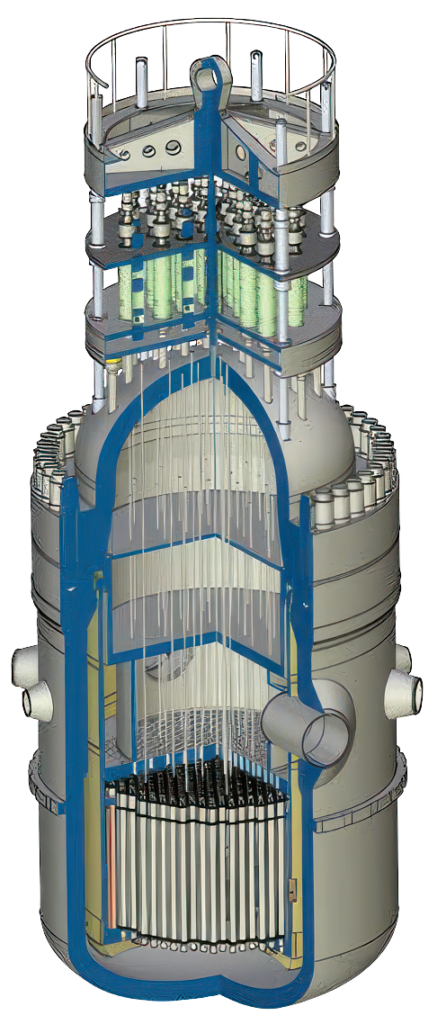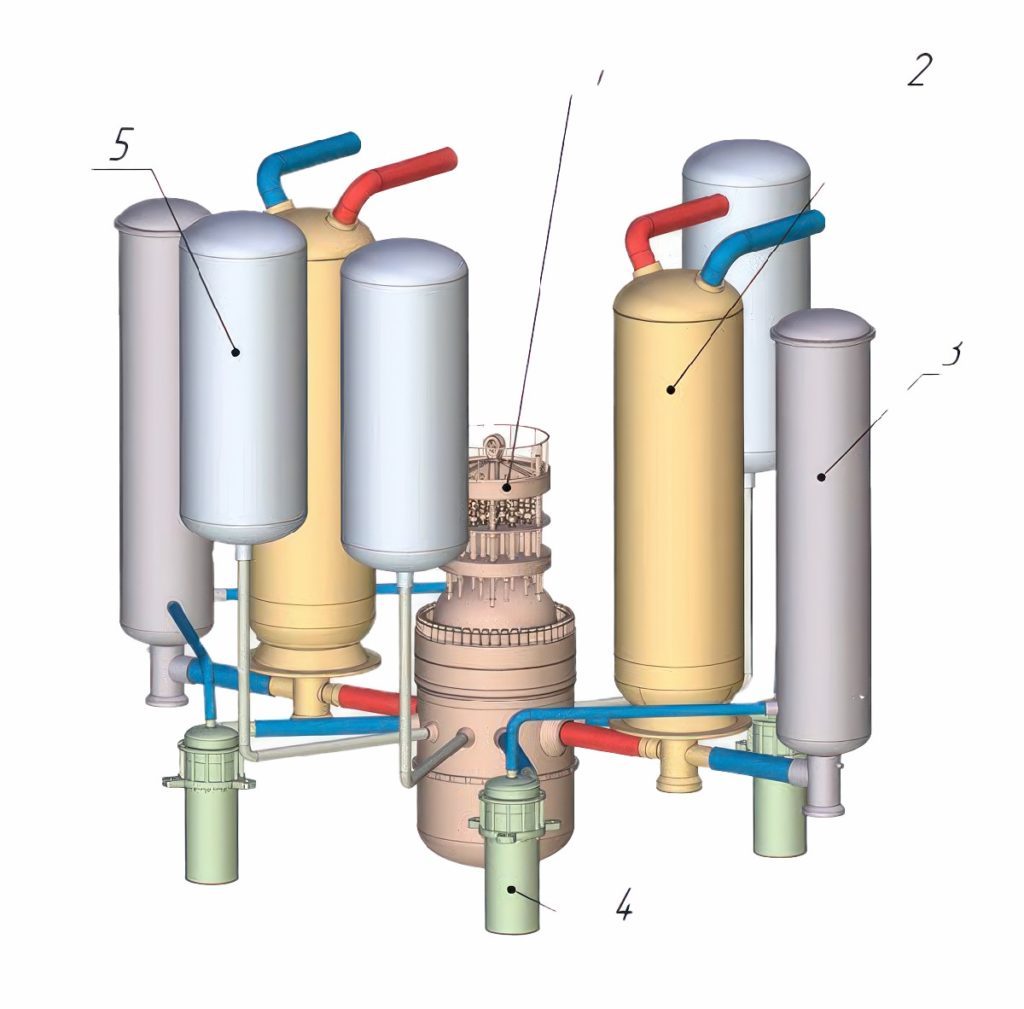
Fresh Look at Reactor Classics
back to contentsIn October, Rosatom top managers, researchers and engineers gathered at the New Nuclear Energy conference to discuss key reactor technology developments in Russia. One of them is a modification of the time-proven VVER design for large and medium-sized reactors. Here is our account of VVER-S, a water-cooled water-moderated power reactor with spectral shift control.
Background
In the 1980s, researchers worldwide considered the concept of reactivity control through the neutron spectrum softening by increasing the moderator volume. The volume could be increased in two ways, either by using displacer rods extracted from the core during the burnup process or by diluting the coolant with heavy water. Spectral shift control was seen as one of the methods of saving fuel through the production of fissile isotopes.
Then the idea was shelved and revived only in 2005. A team under the leadership of Vladimir Asmolov (now Advisor to Rosatom Director General) started the work to develop a ‘super VVER’. Among other things, they concentrated on the development of a spectral shift control reactor, for which they chose a medium-sized reactor design with a power capacity of 600 MWe. The estimated reproduction factor for VVER-S was 0.7 to 0.8, while conventional VVER reactors have a factor of 0.35 to 0.4. The results obtained during the first R&D phase laid the foundation for the next development run. In 2019–2020, the work on this VVER concept continued. The research conducted by the team proved the possibility of building a cost-efficient nuclear station with a VVER-S reactor.
The current R&D activities in the VVER-S project are aimed at solving five tasks. The first is to reduce the consumption of natural uranium in the open nuclear fuel cycle. The second task is to ensure that the reactor can operate efficiently with a full uranium-plutonium core and a reproduction factor of 0.7 to 0.8 in a closed nuclear fuel cycle. Third, the reactor will be capable of operating in a load following mode in the daily range of 100–40–100 %. Fourth, construction time and cost need to be reduced with fundamentally new design solutions. And the fifth task is to reduce the amount of radioactive waste.
The VVER-S concept relies on the experience gained from the operation of conventional VVER reactor units. Although it cannot be claimed that the solutions considered for VVER-S are absolutely novel, the researchers, engineers and designers have studied a wide range of proposals that might improve the reactor performance. With a combination of innovative solutions, the new design can be very promising for the domestic and international markets.

The VVER-S technology is included in Russia’s Nuclear Development Strategy 2050 and Prospects 2100 approved by the Rosatom Supervisory Board in 2021.
How it works
“The conventional VVER technology provides for the initial reactivity margin for burnup and absorption control to be compensated by the boron system, that is, by changing the concentration of boric acid in the primary coolant,” explains Viktor Mokhov, Head of the VVER-S project management office.
Spectral shift in the VVER-S reactor is controlled by changing the water-uranium ratio during the reactor operation at power. This is achieved by mechanically removing water displacer rods located in special fuel assembly channels in the core. Since the displacers are immersed in the core at the beginning of the fuel cycle, there is less moderator in the reactor and the neutron spectrum is harder. This decreases the fission cross-section of odd fissile isotopes and increases the resonance capture cross-section of the uranium 238 isotope. The both effects reduce breeding in the core and contribute to the accumulation of the fissile plutonium 239, which saves fissile material in the annual fuel load. Another effect of spectrum hardening is a higher fraction of fissions in the uranium 238 isotope. When the displacer rods are removed, the neutron spectrum shifts from hard to thermal and reactivity increases.

The use of displacers to control reactivity in the burnup process makes it possible to abandon the use of boron control during the reactor operation at power. However, it is difficult to fully abandon boron control in VVER-type reactors as this design requires two independent safety systems based on different physical principles to be used to put and keep the reactor in a subcritical state.
Fuel and equipment specifics
The developers believe VVER-S to be an evolution of the VVER technology facilitating the effective transition from an open to closed nuclear fuel cycle.
Two fuel assembly designs are considered for VVER-S. The first one is of conventional type, but has an increased number of channels for control rods, with some of ‘gray’ control rods to be used for reactivity control. The second design is evolutionary, with smaller spaces between the fuel rods and displacer channels, which make it possible to change the water-uranium ratio in the fuel assemblies within the range of 1.5 to 2.0.
Time-proven solutions will be used as much as possible for VVER-S fuel rods and main reactor systems. These are the solutions tested and employed in the AES 2006 and VVER-TOI designs. The reactor will have a thermal capacity of 1,600 MW and an electrical capacity of up to 650 MW with an efficiency rate of 38 %. It is planned to use a large reactor vessel designed for VVER 1000 to hold the required amount of fuel and displacers.
The entire VVER-S core will be loaded with uranium-plutonium fuel, so the power plants with this reactor design will most effectively fit into the closed nuclear fuel cycle concept.
Kola NPP
The medium power capacity chosen for VVER-S will enable Rosatom to make a competitive offer to those customers who plan to replace the retiring coal-fired power plants or supply power to the regions with underdeveloped grid infrastructure or isolated grids.
The Kola NPP was selected to build the first power unit with a VVER-S reactor because its existing Generation I VVER 440 power units are to be decommissioned soon. The current General Layout for Power Facilities in the Russian Federation provides for a VVER-S unit to be built by 2035 if its technical solutions are justified and the design proves to be competitive with conventional VVER reactors and alternative power sources. VVER-S power units could also be offered to international customers after the technology is tested at the Kola NPP and the efficiency of the new reactor is confirmed.
R&D phases
As the preliminary R&D phase was completed, the project entered a full-scale engineering phase, during which the basic design solutions will be developed for the reactor unit and the power plant. Research is also underway to justify the design solutions adopted for the VVER-S project. A set of documents will be produced by the end of 2024 to enable the assessment of costs, development prospects, etc. Commissioning of the first VVER-S unit at the Kola NPP is scheduled for 2035.




